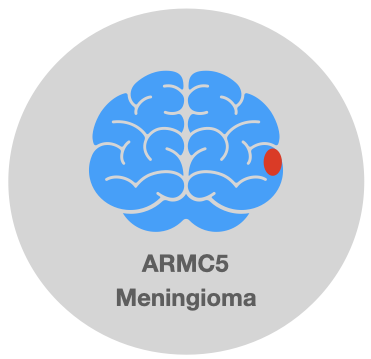ARMC5 Mutations and Meningioma

ARMC5 gene
The ARMC5 gene codes for a member of the ARM (armadillo/beta-catenin-like repeat) superfamily. ARM family members are observed near the nucleus and may play a role as a tumor suppressor through protein-protein interactions. Germline mutations in the ARMC5 gene are associated with primary bilateral macronodular adrenal hyperplasia (PBMAH). However, recent evidence shows the association of mutations with meningioma. Here we summarize evidence from Nucleati Germline Cancer Evidence Base, discussing the association between a germline mutation of the ARMC5 gene and meningioma.
Molecular genetics studies
Brain MRI from two sisters (46 and 58 years old) from Brazil who had been diagnosed with PBMAH showed the presence of meningiomas. Although physicians did not test mutations in ARMC5, this was the early report of associations of meningioma with PBMAH. Similarly, a genetics study of a Brazilian family with 47 members with PBMAH identified an association of germline ARMC5 mutation with PBMAH and intracranial meningiomas (p.Leu365Pro). A genetics study of a German family with 16 members identified heterozygous germline mutation in the ARMC5 gene (p.A110fs*9) with intracranial meningioma.
Molecular genetics analysis of a 64-year-old Portuguese male with meningioma in posterior left temporal convexity revealed a heterozygous mutation (c.1379T>C) in the ARMC5 gene. However, although carriers of this mutation, his 41-year-old son and 37-year-old daughter did not show evidence of meningioma.
Similarly, a brain MRI of a 65-year-old Japanese female with PBMAH and heterozygous mutation (p.R267* and c.799C>T) showed a dural-based tumor on the right frontal convexity. Her 39-year-old son and 36-year-old daughter also had this mutation and PBMAH.
Conclusion
From the above discussion and evaluating the available evidence, we can establish an association between germline gene mutations in the ARMC5 gene and meningioma. Further clinical investigations are needed to find more possible mutations in this gene and associated meningioma.
References
- Alencar, G. A., Lerario, A. M., Nishi, M. Y., Mariani, B. M. D. P., Almeida, M. Q., Tremblay, J., ... & Fragoso, M. C. B. V. (2014). ARMC5 mutations are a frequent cause of primary macronodular adrenal hyperplasia. The Journal of Clinical Endocrinology & Metabolism, 99(8), E1501-E1509.
- Elbelt, U., Trovato, A., Kloth, M., Gentz, E., Finke, R., Spranger, J., ... & Schneider, J. G. (2015). Molecular and clinical evidence for an ARMC5 tumor syndrome: concurrent inactivating germline and somatic mutations are associated with both primary macronodular adrenal hyperplasia and meningioma. The Journal of Clinical Endocrinology & Metabolism, 100(1), E119-E128.
- Ferreira, M. J., Pedro, J., Salazar, D., Costa, C., Aragão Rodrigues, J., Costa, M. M., ... & Carvalho, D. (2020). ARMC5 primary bilateral macronodular adrenal hyperplasia associated with a meningioma: a family report. Case Reports in Endocrinology, 2020.
- Jojima, T., Kogai, T., Iijima, T., Kato, K., Sagara, M., Kezuka, A., ... & Aso, Y. (2020). Genetic alteration of ARMC5 in a patient diagnosed with meningioma and primary macronodular adrenal hyperplasia: a case report. European Journal of Endocrinology, 183(6), K7-K12.
- Lee, S., Hwang, R., Lee, J., Rhee, Y., Kim, D. J., Chung, U. I., & Lim, S. K. (2005). Ectopic expression of vasopressin V1b and V2 receptors in the adrenal glands of familial ACTH‐independent macronodular adrenal hyperplasia. Clinical Endocrinology, 63(6), 625-630.